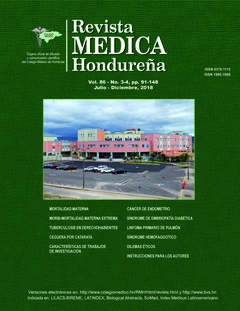Endometrial Cancer. Case report and literature review
DOI:
https://doi.org/10.5377/rmh.v86i3-4.12175Keywords:
Endometrial cancer, Obesity, Risk factorsAbstract
Background: Endometrial cancer (EC) according to statistics is the most common gynecological tumor in developed countries, where its incidence has been increasing. Historically, EC has been classified into two types: Type I (endometrioid), representing 80-90% of cases; type II (non-endometrioid, such as that of serosal and clear cells, undifferentiated carcinomas). As an important data, most patients are diagnosed when the disease is in the early stages or the injury is still confined to the uterus. Conventional treatment is a primary hysterectomy plus bilateral salpingoophorectomy, depending on the stage of the disease. Clinical case: A 58-year-old patient who enters the Hospital of San Marcos, Ocotepeque, with transvaginal bleeding of 1 month of evolution, chronic hypertension and type I obesity. Transvaginal ultrasound detected endometrial thickening, but the biopsy diagnosed Endometrial Adenocarcinoma type Endometroid FIGO Grade II-III. Conclusion: In the presence of abnormal uterine bleeding in peri and postmenopausic women, with associated risk factors, endometrial cancer should be suspected. An early-stage diagnosis improves the treatment and prognosis of patients.
Downloads
817




